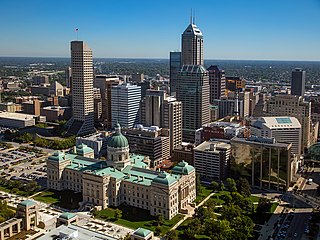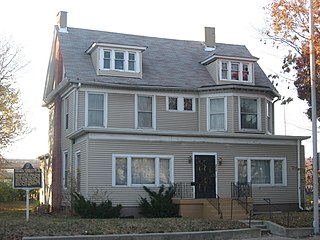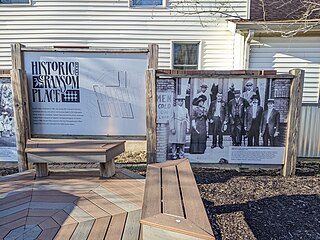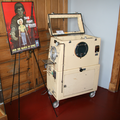
Indiana University Bloomington is a public research university in Bloomington, Indiana. It is the flagship campus of Indiana University and its largest campus with over 40,000 students. Established as the state's seminary in 1820, the name was changed to "Indiana College" in 1829 and to "Indiana University" in 1838.

The Hong Kong Museum of Medical Sciences was established in 1996. It is in a renovated three-story Edwardian-style building, at 2 Caine Lane at the Sheung Wan, Hong Kong Island, Hong Kong. It is also referred to as Old Pathological Institute.

The Indiana University School of Medicine (IUSM) is a major, multi-campus medical school located throughout the U.S. state of Indiana and is the graduate medical school of Indiana University. There are nine campuses throughout the state; the principal research, educational, and medical center is located on the Indiana University–Purdue University Indianapolis (IUPUI) campus in Indianapolis. With 1,461 MD students, 195 PhD students, and 1,442 residents and fellows in the 2023–24 academic year, IUSM is the largest medical school in the United States. The school offers many joint degree programs including an MD/PhD Medical Scientist Training Program. It has partnerships with Purdue University's Weldon School of Biomedical Engineering, other Indiana University system schools, and various in-state external institutions. It is the medical school with the largest number of graduates licensed in the United States per a 2018 Federation of State Medical Boards survey with 11,828 licensed physicians.
White River State Park is an urban park in downtown Indianapolis, Indiana. Situated along the eastern and western banks of its namesake White River, the park covers 267 acres (108 ha). The park is home to numerous attractions, including the Eiteljorg Museum of American Indians and Western Art, the Indiana State Museum, the Indianapolis Zoo, the NCAA Hall of Champions, Victory Field, Everwise Amphitheater, and White River Gardens.

Logansport State Hospital is a psychiatric hospital located in Logansport, Indiana, United States.

Crispus Attucks High School is a public high school of Indianapolis Public Schools in Indianapolis, Indiana, U.S. Its namesake, Crispus Attucks, was an African American patriot killed during the Boston Massacre. The school was built northwest of downtown Indianapolis near Indiana Avenue and opened on September 12, 1927, when it was the only public high school in the city designated specifically for African Americans.

The Indiana State Museum is a museum located in downtown Indianapolis, Indiana, United States. The museum houses exhibits on the science, art, culture, and history of Indiana from prehistoric times to the present day.

Downtown Indianapolis is a neighborhood area and the central business district of Indianapolis, Indiana, United States. Downtown is bordered by Interstate 65, Interstate 70, and the White River, and is situated near the geographic center of Marion County. Downtown has grown from the original 1821 town plat—often referred to as the Mile Square—to encompass a broader geographic area of central Indianapolis, containing several smaller historic neighborhoods.

Central State Hospital, formerly referred to as the Central Indiana Hospital for the Insane, was a psychiatric treatment hospital in Indianapolis, Indiana. The hospital was established in 1848 to treat patients from anywhere in the state, but by 1905, with the establishment of psychiatric hospitals in other parts of Indiana, Central State served only the counties in the middle of the state. In 1950, it had 2,500 patients. Allegations of abuse, funding shortfalls, and the move to less institutional methods of treatment led to its closure in 1994. Since then efforts have been made to redevelop the site for various uses.
Indiana University Health, formerly known as Clarian Health Partners, is a nonprofit healthcare system located in the U.S. state of Indiana. It is the largest and most comprehensive healthcare system in Indiana, with 16 hospitals under its IU Health brand and almost 36,000 employees. It has a partnership with the Indiana University School of Medicine (IUSM). The IU Health system has a total capacity of 2,696 beds.

Strecker Memorial Laboratory is a historic building located in Southpoint Park on Roosevelt Island in New York City.

Vincennes Historic District is a national historic district located at Vincennes, Knox County, Indiana. The district encompasses 1,161 contributing buildings, 5 contributing sites, 9 contributing structures, and 37 contributing objects in the central business district and surrounding residential sections of Vincennes. It developed between about 1787 and 1955, and includes notable examples of Federal, Greek Revival, Italianate, and Classical Revival style architecture. Located in the district are the separately listed George Rogers Clark National Historical Park, William Henry Harrison Home, Indiana Territorial Capitol, Old State Bank, and St. Francis Xavier Cathedral and Library. Other notable buildings include the Brouillet House, Knox County Courthouse (1873), Ellis Mansion, Lacy House, Dunn House (1840), Summers House, Fyfield House (1860), Grannan House, Cauthorn House, Gimble-Bond Store (1879), and Rabb House.

Indiana State Federation of Colored Women's Clubs, also known as the Minor House, is a historic National Association of Colored Women's Clubs clubhouse in Indianapolis, Indiana. The two-and-one-half-story "T"-plan building was originally constructed in 1897 as a private dwelling for John and Sarah Minor; however, since 1927 it has served as the headquarters of the Indiana State Federation of Colored Women's Clubs, a nonprofit group of African American women. The Indiana federation was formally organized on April 27, 1904, in Indianapolis and incorporated in 1927. The group's Colonial Revival style frame building sits on a brick foundation and has a gable roof with hipped dormers. It was listed on the National Register of Historic Places in 1987.

Ransom Place Historic District is a national historic district in Indianapolis, Indiana, United States. The district consists mainly of a six-square block in a historically Black residential section of Indianapolis, located just one block from Indiana Avenue. It was originally developed during the 1880s and 1890s, coinciding with the growth of Indiana Avenue as the central commercial district for Indianapolis's Black population at that time. It was listed on the National Register of Historic Places in 1992.

Emerson Hall was the first building constructed on the IU Medical Center campus as part of the Indiana University School of Medicine. The construction of the building marked the beginning of the presence of IU in Indianapolis and the growth of Indiana medical education. The building is located in between the University Hospital Cancer Pavilion to its south and the Van Nuys Medical Science Building to its north, and across from Willis D. Gatch Hall to its west.

Fesler Hall is located on the western end of Indiana University Indianapolis campus as part of the IU Medical Center. The building was the former site of the Indiana State Board of Health headquarters until being occupied by Indiana University in 1949. During the board of health's occupation, the building served as a hub for public health outreach and education programs in cooperation with the Indiana University School of Medicine. Indiana University used the building as a new center for clinical programs located on the campus to compensate the growing medical student population. Fesler Hall is located in a cluster of medical facilities that include the Eugene and Marilyn Glick Eye Institute, William H. Coleman Hall, Robert W. Long Hall, Willis D. Gatch Hall, and the School of Nursing Building.

Robert W. Long Hall is a building part of the Indiana University Medical Center on the campus of Indiana University–Purdue University Indianapolis. The building houses various departments from the Indiana University School of Medicine (IUSM). The Robert W. Long Hospital was the first hospital constructed on the university campus that served as a training institution for medical students in Indianapolis. Long Hall served as one of the early focal points for the growth of the IUSM with many buildings including the first medical school building, Emerson Hall. Other early buildings included Willis D. Gatch Hall, William H. Coleman Hall, and Fesler Hall. Newer buildings constructed in the cluster include the School of Nursing Building and the Eugene and Marilyn Glick Eye Institute.
Willis D. Gatch Hall, shortened to Gatch Hall, was constructed as an addition for the former Robert W. Long Hospital. Gatch Hall served as additional space for outpatient services, clinical services, and imaging services. Following the construction of University Hospital and the reorganization of medical services on the IU Medical Center, Gatch Hall would transition to an academic center supporting the School of Allied Health, Division of Nuclear Medicine, and Department of Radiology. The building continues to serve as an academic center for various divisions and departments within the IU School of Medicine. Gatch Hall was one of the early buildings on the IU Medical Center alongside Fesler Hall, Emerson Hall, and Coleman Hall. The Eugene and Marilyn Glick Eye Institute and the School of Nursing Building are more recent additions to the IU Medical Center cluster.
The Van Nuys Medical Science Building is located on the IUPUI Campus as part of the IU Medical Center. The building serves as an academic and research facility for the IU School of Medicine providing significant laboratory space for the campus. Originally, the building served to consolidate academic laboratory functions on the campus into a singular facility and provide space for the creation of a more robust medical library. Upon completion, the building provided new research space for Robert W. Long Hall, William H. Coleman Hall, Fesler Hall, Willis D. Gatch Hall, and Emerson Hall. The building is located just north of Emerson Hall and University Hospital, and adjacent to the Medical Research and Library Building.

























